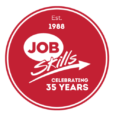
Exploring the Profession of a Registered Massage Therapist in Ontario
If you’re someone intrigued by health, wellness, and the power of human connection, becoming a Registered Massage Therapist (RMT) in Ontario might be the perfect career path for you. This role strikes a unique balance between science and compassion, granting professionals the opportunity to make a tangible difference in other people’s lives. Let’s break down what this profession entails and help you decide if this is the right move for your career.
FIND THE JOB YOU WANT! Finding your next job doesn’t have to be a solo act. Apply to a job on the Job Skills job board and one of our employment team members will help you through the process. https://www.jobskills.org/job-board/
A Day in the Life of an RMT
A typical day for an RMT is a mix of hands-on client care and preparation. You’ll likely start your day by reviewing your schedule and preparing treatment rooms—ensuring everything is clean, organized, and ready to welcome clients. Before laying a single hand on a client, RMTs take time to consult with them, review health histories, and assess their needs. From there, the real work begins!
Depending on a client’s preferences or needs, an RMT might perform different types of massage techniques, like Swedish, deep tissue, or sports massage. The goal is always the same—help relieve stress, alleviate pain, and improve the client’s overall well-being. Once the session ends, you’ll document the client’s progress and might share tips or exercises to help them manage their condition between sessions.
Work schedules vary. Some RMTs stick to typical daytime hours, while others thrive on evenings or weekends to accommodate clients’ availability. Whether in a spa, wellness clinic, or private practice, each day brings new faces and challenges.
Key Responsibilities
The work of an RMT revolves around healing and care, but there’s more to it than the massage itself. Some of the main tasks include:
- Assessing a client’s physical condition through consultations and reviewing their medical history.
- Tailoring massage techniques to address specific concerns like chronic pain, mobility issues, or general relaxation needs.
- Educating clients about how massage can benefit them and recommending treatment plans.
- Keeping a consistent log of sessions to track client progress.
- Staying up-to-date on the latest techniques and wellness trends.
The Most Rewarding Aspect
Ask an RMT what keeps them going, and they’re likely to talk about the tangible impact they have on clients. Whether it’s helping someone recover from an injury or simply reducing the stress of a busy life, there’s a deep satisfaction in seeing someone leave your treatment room feeling better than they did when they arrived. For many RMTs, the relationships they build with clients and the ability to truly help others are what make the job so rewarding.
Opportunities for Growth and Specialization
Massage therapy offers room to grow! Over time, RMTs can specialize in specific areas like prenatal massage, lymphatic drainage, or sports injury rehab. Some even further their education to offer complementary services, such as acupuncture or physiotherapy. If entrepreneurship appeals to you, opening your own practice is also a path many RMTs choose after gaining experience.
How Do You Become an RMT?
To be a Registered Massage Therapist in Ontario, you’ll need to complete a diploma program in massage therapy from a recognized institution. After that, you’ll need to pass the CMTO (College of Massage Therapists of Ontario) licensing exams. Many RMTs also gain hands-on experience through apprenticeships or by starting their career in established wellness centers.
The process requires a mix of focus, passion, and dedication to succeed, but the end result is a rewarding profession.
What Skills Do You Need to Succeed?
To thrive as an RMT, you’ll need technical expertise and soft skills. Proficiency in different massage techniques is essential, but so is adaptability. No two clients are the same, so you’ll need sharp assessment skills to tailor each session.
Beyond that, communication skills are vital. Clients need explanations they can easily understand, and building trust is key for repeat visits. Teamwork also plays a big part if you’re working in a spa or clinic with other practitioners. And don’t underestimate physical endurance—this is a hands-on role, quite literally! Staying healthy and strong ensures you can show up 100% for your clients every day.
Want to Stand Out?
To stand out as an RMT, sharpen your customer service skills as much as your massage technique. Building an excellent rapport with clients will not only boost their satisfaction but also strengthen word-of-mouth recommendations. Staying informed about the latest industry trends, such as emerging techniques or wellness practices, can also set you apart.
Empowering Your Job Search with Tools and Solutions for Success: Job Skills’ customized employment solutions are available to every job seeker, including youth, newcomers, persons with disabilities, women, and anybody else who may be searching for a job. https://www.jobskills.org/job-seekers/
Challenges of Being an RMT
While the rewards are high, being an RMT isn’t without challenges. It’s physically demanding work, as you’ll spend long hours on your feet. There’s also an emotional component; you’re often helping people through pain and stress, which can sometimes be heavy to shoulder.
Another challenge is addressing misconceptions about massage therapy. Some see it purely as a luxury, not understanding its role as a legitimate therapeutic practice. RMTs play a part in educating clients about the true health benefits of their work.
Breaking Into the Profession
If you’re new to massage therapy, start by researching accredited programs in Ontario. Many massage schools offer job placement programs or networking opportunities with clinics and spas. Volunteering or creating opportunities for hands-on practice while you’re still learning can also help you build confidence and connections.
Opportunities for Advancement and Impact
There’s so much potential for career growth in this field. Whether you want to climb the ranks at a prestigious spa, establish your own practice, or even teach future RMTs, the possibilities are expansive.
As for innovation, the industry continues to evolve with new research and technologies, like integrating massage with other therapies or exploring tools to enhance manual techniques. The growing awareness around mental health also means massage therapy is being recognized for its broader wellness benefits. This is an area where you can really make an impact.
One Piece of Advice
If you’re considering becoming an RMT, remember that this career is about more than applying techniques—it’s about compassion and connection. Always prioritize listening to your clients. Their feedback and trust are as important as your technical skills.
Being an RMT in Ontario is a career that combines hands-on work, personal interactions, and a commitment to improving others’ lives. If that excites you, it could be the perfect path to pursue!

